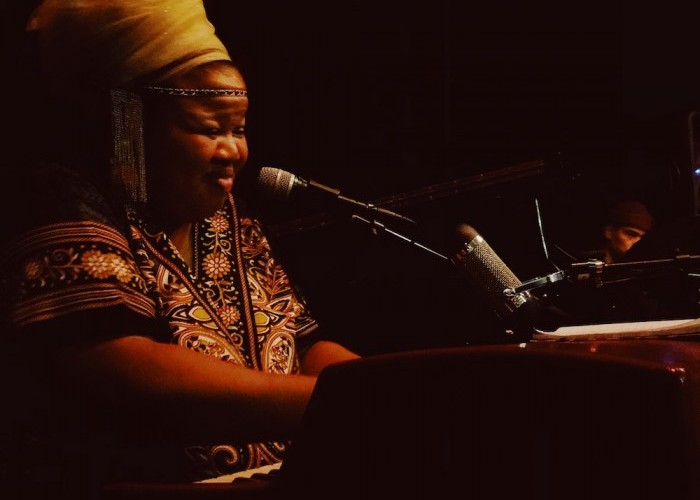Apr 2, 2024 12:59 PM
Saxophonist, Sonic Explorer Casey Benjamin Dies at 45
Casey Benjamin, the alto saxophonist, vocalist, keyboardist and producer who stamped his distinctive sounds on the…

Angel Bat Dawid’s The Oracle splices together sonic fragments, spoken word and more.
(Photo: Alejandro Ayala)Angel Bat Dawid, a Chicago-based avant-garde composer, improviser and multi-instrumentalist, hails from seven generations of ministers, and her approach to music never loses sight of the spiritual.
As she puts it: “My music, sometimes, it’s just something comes over me, and then something pours out—that’s all improvisation really is. You go with the sound and then it’ll tell you to trust that the next thing you’re gonna play is right—and it always is.”
Most of her artful creations arise during serendipitous moments, and her new album, The Oracle (International Anthem), shares a Sun Ra-infused mixture of samples, sonic fragments and spoken word—somehow austere and lush, simultaneously—built upon elements drawn from poems by Yusef Lateef and Margaret Burroughs, with Bat Dawid’s clarinet brilliantly soaring and swooping to mimic vocal lines. It’s a fierce one-woman show, with Bat Dawid playing every instrument on the album (save for Asher Simiso Gamedze’s drumming on “Cape Town”), singing and completing the mix herself.
The 39-year-old artist’s compositional style emerged over time as she recorded various pieces so The Brotherhood, her ensemble, could be kept appraised of new works. But Bat Dawid, a self-professed vinyl addict, also brought a background in hip-hop production to the proceedings.
The Oracle unites a series of influences from her singular background, including time spent living in Kenya as a child of minister parents, who later “discovered their identity as ‘Hebrew,’” or Black Hebrew Israelites. She describes her earliest experiences learning music as being centered in spiritual spaces and churches, and took her name—which translates to “Daughter of David”—from the Old Testament David, whom she admires for his ecstatic musicality and passion.
Returning to the States as an adolescent, Bat Dawid recalled feeling out of place, and found comfort in music, particularly Mozart’s clarinet concertos. But during her early 20s, Bat Dawid’s life was interrupted by a serious health condition, and upon recovery from surgery to address a benign brain tumor, she sought to explore the healing powers of music.
The entirety of the composer’s past finds its way into The Oracle, an album shuttled into life through the use of a multitrack recording app on her phone, along with collections of sounds from traveling, as well as jams in London and South Africa. Bat Dawid, who refers to herself a “sonic archaeologist,” seeks to find the sonic imprint of past events on physical spaces, incorporating them into her own music.
To collect these “vibes,” she’s taken her horn to spaces in Chicago’s Cottage Grove neighborhood—including a lot where the Pershing Hotel, which hosted pianist Ahmad Jamal in 1958 as he recorded At The Pershing: But Not For Me, once stood—to gather the feeling of what’s there, and use it to influence and inspire her instantaneous compositions.
As part of her constant search to find the undercurrent of the African Diaspora’s spiritual practices, she titled “Impepho,” a cut off the new album, for a plant that, when burnt, is said to enable contact with one’s ancestors and with the divine. She’s also introduced the music of South Africa into the song, finding inspiration in a 21st-century electronic music called gqom, joking that “‘Impepho’ is like an out-jazz version” of the genre.
On some level, Bat Dawid continued, she thinks of her music as following her family’s legacy of ministry: “Some of my favorite composers and artists have been my best friends during rough times. ... I prayed over each and every song I did, and I meditated that it would bring peace and harmony, and all those good things. I [make] intentionally good music—there’s a lot that’s intentionally perverse and weird out there. So, I’m like, well, if they can go hard on that, I should be able to go hard on doing something that can heal people.” DB

Benjamin possessed a fluid, round sound on the alto saxophone, and he was often most recognizable by the layers of electronic effects that he put onto the instrument.
Apr 2, 2024 12:59 PM
Casey Benjamin, the alto saxophonist, vocalist, keyboardist and producer who stamped his distinctive sounds on the…

“He’s constructing intelligent musical sentences that connect seamlessly, which is the most important part of linear playing,” Charles McPherson said of alto saxophonist Sonny Red.
Feb 27, 2024 1:40 PM
“I might not have felt this way 30 to 40 years ago, but I’ve reached a point where I can hear value in what people…

Albert “Tootie” Heath (1935–2024) followed in the tradition of drummer Kenny Clarke, his idol.
Apr 5, 2024 10:28 AM
Albert “Tootie” Heath, a drummer of impeccable taste and time who was the youngest of three jazz-legend brothers…

“Both of us are quite grounded in the craft, the tradition and the harmonic sense,” Rosenwinkel said of his experience playing with Allen. “Yet I felt we shared something mystical as well.”
Mar 12, 2024 11:42 AM
“There are a few musicians you hear where, as somebody once said, the molecules in the room change. Geri was one of…

Henry Threadgill performs with Zooid at Big Ears in Knoxville, Tennessee.
Apr 9, 2024 11:30 AM
Big Ears, the annual four-day music celebration that first took place in 2009 in Knoxville, Tennessee, could well be…